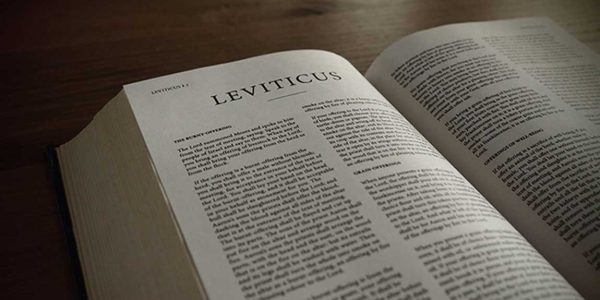The Book of Leviticus – Holiness in the Presence of God
The Book of Leviticus reveals God’s standards for holiness, worship, and atonement through the sacrificial system. It teaches how sinful people can live in fellowship with a holy God through obedience, purity, and the shedding of blood.
Worship, Atonement & Holiness in the Tabernacle
Worship, Atonement & Holiness in the Tabernacle
The Book of Leviticus is the divine manual for worship in ancient Israel. Positioned between Exodus and Numbers, it continues the story of God’s covenant relationship with His people—detailing how they must live in purity and reverence before Him. Every ritual, regulation, and sacrifice points to God’s holiness and His mercy through substitution.
✔ Emphasizes holiness, purity, and reverence in daily life and worship
✔ Introduces the sacrificial system and priestly duties
✔ Details laws regarding clean and unclean practices
✔ Foreshadows Christ’s ultimate atonement and priesthood
📖 Key Verse: “For I am the Lord your God: ye shall therefore sanctify yourselves, and ye shall be holy; for I am holy.” – Leviticus 11:44
🔎 Leviticus teaches that God’s presence requires purity, but His mercy makes a way through blood and obedience.
Authorship & Structure
Date Written: Approximately 1445–1405 BC
Written By: Moses
Language: Originally written in Hebrew
Chapters: 27 chapters
Primary Audience: The Israelites, especially priests and Levites
🔎 Leviticus is God’s call to holiness for His people, showing that access to His presence requires cleansing, sacrifice, and obedience.
📚 Chapter Structure of Leviticus
Chapters 1–7 – Sacrificial Offerings
Instructions for burnt, grain, peace, sin, and guilt offerings for both individuals and the community.
📖 Chapters 8–10 – Priestly Ordination & Failure
Aaron and his sons are consecrated as priests; Nadab and Abihu are judged for offering strange fire.
📖 Chapters 11–15 – Clean and Unclean Laws
Regulations on clean/unclean animals, purification after childbirth, leprosy, and bodily discharges.
📖 Chapter 16 – The Day of Atonement
The high priest enters the Most Holy Place once a year to atone for the sins of the people.
📖 Chapters 17–20 – The Holiness Code (Part 1)
Laws on sexual purity, justice, idolatry, and reverence—God’s call to moral holiness.
📖 Chapters 21–22 – Laws for Priests
Qualifications, purity standards, and regulations for offerings brought by priests.
📖 Chapters 23–25 – Sacred Appointed Times
Instructions for Sabbaths, feast days, and the Year of Jubilee.
📖 Chapter 26 – Blessings and Curses
God outlines rewards for obedience and consequences for disobedience.
📖 Chapter 27 – Vows and Dedications
Rules concerning vows, offerings, and things dedicated to the Lord.
Key Themes & Instructions in Leviticus
📖 Holiness – “Be ye holy, for I am holy” is the central call (Leviticus 11:44).
📖 Sacrifice – Blood offerings make atonement and point to the cross.
📖 Separation – God’s people are to be distinct from the nations.
📖 Cleansing – Laws about leprosy, unclean foods, and bodily defilements show the need for spiritual purity.
📖 Feasts & Sabbaths – God’s appointed times teach rest, remembrance, and redemption.
📖 Ethical Living – Justice, mercy, and moral conduct are vital to holiness.
📖 Priestly Ministry – Leadership must reflect God’s holiness.
📖 Divine Presence – God dwells among His people but only through holiness and obedience.
🔎 Every command, ritual, and law teaches the seriousness of sin and the mercy of God in providing a way to dwell with Him.
Prophetic Patterns
🔮 The Sacrificial System → Points to Christ’s once-for-all sacrifice (Hebrews 10:1-10)
🔮 The High Priest → A shadow of Jesus, our eternal High Priest (Hebrews 4:14)
🔮 The Day of Atonement → A picture of Christ’s atonement for sin (Leviticus 16 → Hebrews 9:12-14)
🔮 The Blood → Symbolizes the life given for sin (Leviticus 17:11 → Matthew 26:28)
🔮 The Year of Jubilee → Anticipates spiritual freedom through Christ (Luke 4:18-19)
Literary Features & Writing Style of Leviticus
📜 Direct Divine Speech – Many chapters begin with “And the LORD spake unto Moses,” indicating direct revelation.
📜 Chiastic Structure – Thematic mirror patterns center around the Day of Atonement.
📜 Ritual Instruction Format – Precise and repetitive instructions reflect God’s exact standards.
📜 Legal Language with Spiritual Purpose – The laws serve both physical and spiritual purification.
Leviticus Compared to Other Torah Books
📖 Genesis – Origins of creation and the covenant family
📖 Exodus – Deliverance and covenant established
📖 Leviticus – Holiness, worship, and God’s dwelling place
📖 Numbers – Wilderness journey and rebellion
📖 Deuteronomy – Covenant renewal and final instructions
Holiness: The Heart of Leviticus
👑 God is holy, and He desires His people to reflect that holiness in all areas of life.
👑 Holiness is not just ceremonial but moral, relational, and practical.
👑 The book of Leviticus shows how sacredness touches everything—from worship to diet to ethics.
🔎 True access to God requires sanctification, but He lovingly provides the way.
Final Reflection: Leviticus’ Call to Holiness & Worship
The Book of Leviticus reminds us that the presence of God is not casual. It requires reverence, purity, and atonement. Though ancient in form, the truths of Leviticus are timeless—pointing us to the Lamb of God who fulfilled every shadow of the law.
📌 Do we approach God with reverence and humility?
📌 Are we living lives set apart, reflecting God’s holiness?
📌 How does Christ’s sacrifice fulfill and elevate the principles of Leviticus in our hearts?
🚀 Leviticus is a call to worship God in spirit and truth—through holiness, obedience, and the blood of the Lamb.

Date Written
1445–1405 B.C.
Written By
Moses
Language
Hebrew
Chapters
27
Buttons in blue have completed chapter notes. Buttons in red are not completed.
